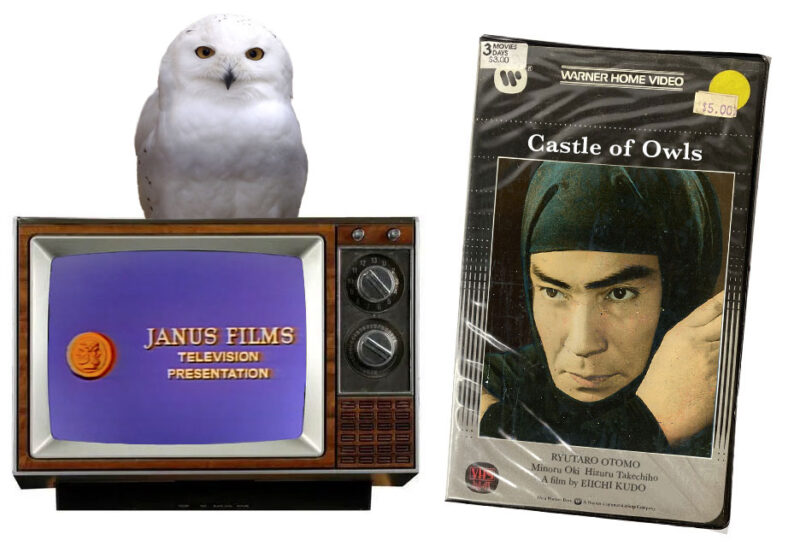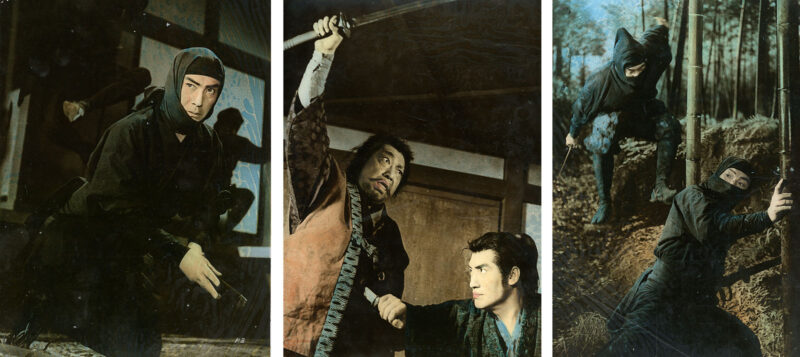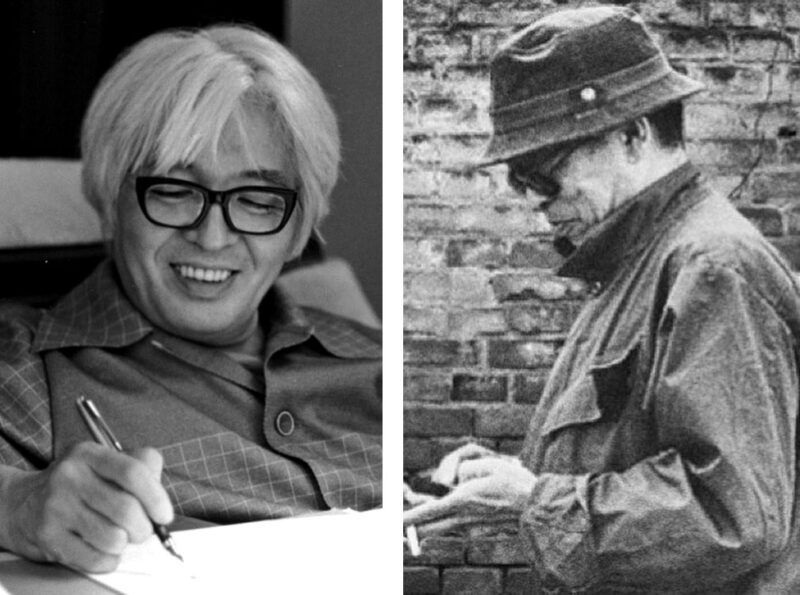I was honored to do a guest spot on the HEROES THREE Podcast this week. These seven year vets covering all things martial arts cinema and Hong Kong action took a step out of their usual comfort zone this summer to feature shinobi media, with my favorite ever ninja movie Castle of Owls being their second feature. I really hope you can all give this a listen, not only for the copious info presented but more for the enthusiasm of new folks discovering the highest end of shinobi cinema. Please visit their excellent page where you can listen below:
I also couldn’t resist the occasion for a quickie new feature, below. Needless to say, if you aren’t familiar with this 1963 classic, the podcast above and the rant below should more than talk you into it. Enjoy…

It is a cool, rainy evening on an alternate planet Earth, during an alternate 1983.
As Richard Gere’s agent takes offers from 20th Century Fox to star in the big budget adaptation of Eric Van Lustbader’s The Ninja, Cannon basks in the success of Revenge of the Ninja and gives Sho Kosugi creative control over five more contracted pictures. Over on the small screen The Last Ninja is about to be picked up for series with a two season commitment, and Sunbow is dubbing episodes of Ninja Hattori-Kun for Western syndication. In comics, multiple American publishers are locked in a bidding war for the translation rights to Ninja Bugeicho, while Marvel has commissioned Frank Miller to create a ninja equivalent of Shang-Chi and directed that multiple other titles incorporate The Hand into storylines immediately. DC Comics follow suit with their own derivatives, while First’s Whisper is optioned by a film producer with visions of Madonna in spandex (he settles for Catherine Mary Stewart and its a better film for it). Ninja media becomes as common as Westerns were in the 1950s, and in a few years a studio exec will pitch a cartoon-ized version of an indie comic featuring turtles to mild to no interest considering the glut already.
This Earth is not going through a ninja boom, or a ninja craze… it is steeped in a ninja movement.
The big difference? How did this world deviate our from less-ninja-ful reality here? Well, over there, Janus films recognizes brilliance when they see it, does not get deterred by the exploitation/grindhouse reputation “ninja” already suffers, and releases Eiichi Kudo’s superb Castle of Owls amidst their requisite Kurosawa and Inagaki/Mifune fare. The West… this reality’s West… sees the high end of the ninja genre, it’s Super Ego, not just it’s Id. They see it isn’t all easily dismissed “chop-sockey” or hokey kids stuff.

It doesn’t stop at the art-house circuit, or David Ansen hosting showings on cable TV’s new A&E network — other labels scoop up titles, dubbed releases of “Band of Assassins” hit video store shelves with lurid color clamshells, while some ill-advised colorized prints of 17 Ninja and The Ninja Hunt find their way to priced-to-sell bins. Someone in Australia makes bank, realizing ten season of The Samurai can easily be re-packaged as “The Ninja Slayer.” Red Shadow, Lion Maru and Henshin Ninja Arashi are as commonly syndicated as Ultraman and Giant Robot. The depth of Japanese shinobi gold is mined for every economic strata and multiple media streams.
This alternate world is a beautiful one, bloated with imported ninja content easily accessible outside Japan. But this world isn’t where we live. Here, few if any even knew of Castle of Owls until the DVD-R trading revolution and message boards of the early 2000s internet made fertile soil for shinobi super-fans to grow.
Better late than never, but not better…

OK, look, I’m realistic… old black & white movies weren’t the easiest sell in the 80s, especially at a time when Ted Turner was pushing hard to colorize Casablanca and Citizen Kane, while Universal was experimenting with colorized Frankensteins (you can see glimpses of this abandoned effort in Weird Science). It was a neon-drenched bright spandex decade and MTV was redefining the human race’s notion of an attention span. So yeah, maybe Shinoda’s Samurai Spy would have gone over everyone’s heads if it aired on cable. But not Owls… Owls was a color-soaked visual masterpiece full of rim-lit night fighting with kinky ninja gals sneaking around and hero not unlike Clint Eastwood in The Outlaw Josey Wales. This utterly accessible, comfortably familiar and profoundly relatable masterpiece of a movie would have shown the newly ninja-obsessed world that there was a higher echelon for shinobi cinema, a superior plain for the entire genre to aspire.
With Castle of Owls as a model for success, it would only have taken a few more such films going wide in the coming years to make a huge difference — Warrior of the Wind comes immediately to mind, and dubbed episodes of Kage no Gundan riding on Sonny Chiba’s Streetfighter notoriety would have easily been a smash hit.
But alas, we do not live on The Planet of Owls.
Stuck in a world whose ‘ninja movement’ only had five good years really and never attained the volume it should have, I continue to be frustrated at how ripped-off we were in the mid-80s. But in a continuing effort since to push the good stuff on folks unaware of its depth, I find Castle of Owls the easiest of the 1960s ninja films to convert a potential new viewer. Few can watch it and not find something to love — from Kurosawa fans to film noir devotees. If you know someone who adores Road to Perdition, show them this next to Conrad Hall’s Oscar-winning cinematography and watch them smile.


YES… there are legit good old ninja movies, even for people who don’t like black & white. It’s a revelation to many, and affirming for the familiar. Movies like Castle of Owls are the next step up from Kosugi and Dudikoff, and if Ninja Scroll or Naruto or countless video games are more your speed, those properties learned all their lessons here.
Heed the words of ace Iga ninja Juzo, and live life like you should… like an owl.
Keith J. Rainville — July, 2024
And here’s that podcast link again – HEROES THREE
